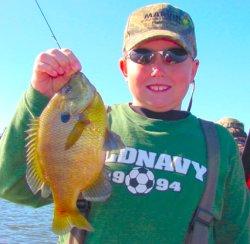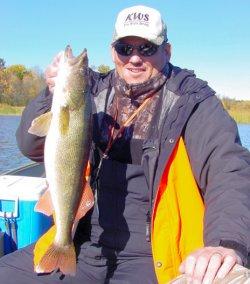The window of opportunity opens and closes quickly when the weather turns cold and surface temperatures fall into the low fifties. The past week has been a fast transition starting with surface temperatures in what I'd call "prime Walleye fishing range" of 56 to 60 degrees and ending with temperatures in the 53 to 57 degree range. Not the end of the fall bite, but a step closer to the last phase of fall fishing and the time for cold water Walleye anglers to start playing by a new set of rules.
Some of the Walleyes that have been most active on weed edges and shallow shoreline breaks are moving into only the premium weed areas. Breaklines where green weed growth is still present continues to hold decent numbers of fish. But baitfish and Walleyes alike are evacuating the dying, brown or "soft" weeds. On lakes where there are good shallow rock areas adjacent to weedy flats, you'll find Walleyes using the rocks on breezy days and off into the deeper edges of the weeds on clam days. These multiple cover spots are good this time of year because the fish don't have to move far for food or cover. It's worth taking a look at these areas every time you go out.
Daily movements of baitfish are important now too. Minnows that ordinarily hide out most days on shallow, sandy weed flats will make a quick move into the super shallow water on warm, sunny days. Calm bays and protected areas with direct sunshine will attract Shiners, young Perch and other baitfish. These movements of baitfish will influence Walleye location on a day by day basis. So even if you know an area that's been holding good numbers of fish, you'll need to fine tune your depth a few times every day. For the rest of the fall season, use this rule of thumb. Stay close to the food supply and you'll find some fish.
Another key to the colder water Walleye bite is to begin fishing early and late in the day. Fish that have been active during the day during the past several weeks are showing a preference for morning and evening. The exception would be breezy days when the Walleye will still move up onto the shallow rocks and green weedline areas I mentioned before. As the water continues to chill and lakes enter the post turnover period, the prime time evening, night and early morning periods will get more and more important.
Walleye presentations are still somewhat varied, but in our area the jig and minnow combinations are all you really need right now. There are still folks fishing with live bait rigs tipped with night crawlers or light jigs tipped with crawlers too. I've used this approach this week to cut down on "snip off" problems from small Pike. The crawlers are overlooked by most of the Pike and even if it's not the perfect bait for Walleye right now, we get enough of them to keep it interesting. Evening and night fishing with crankbaits is an option as well. Shallow runners like the #4 Hornet by Salmo, The Husky Jerk or #5 Shad Raps trolled in 5 to 8 feet of water will produce plenty of "night biters", especially during this full moon period.
Panfishing has occupied a lot of my mid day fishing time this week and I'd say that it's getting easier to locate schools in open water every day. On Wednesday, we were able to locate several schools of Crappie and Bluegills all within a few hundred feet of each other. This is a big improvement over a week ago when there were still lots of fish nearer to the weedline and tougher to pick up on the Lowrance. Crappies have been most active earlier in the morning and each day we've found that almost all of our Crappie catches have come within the first couple of hours in the morning. After that, the Bluegills keep the action going for a couple more hours until about lunchtime. Mid day fishing is slower, but some fish continue to bite. The action picks up again a few hours before sunset and the peak is an hour or so before dark.
The presentation doesn't change much for me. A 1/16 ounce jig tipped with a minnow for Crappie or tipped with a worm for the ‘gills. We tend to keep this approach really simple, but it has been proven over time and keeps working. Why change a good thing?
Perch action has slowed somewhat from its peak a week ago, but there are still plenty of nice Jumbos and even some "magnums" in the shallow weeds and on shallow rocks. A wind makes the Perch fishing better, but unlike the Walleye. Those shallow Perch spots do produce at least some action even on the calm days. If anything, the size may be smaller on calm days with a higher percentage of larger fish caught during those windy times. You will catch some good Perch while you drift or back troll for Walleye. But if you really want to get into them, hover or slow drift with your jig held vertically and directly below the boat. Even in the shallows, the Perch catch is much better when we just drop the jig over the side and let the fish do the work. When the average size gets too small, let the boat drift off into a new area until you get back into the better ones.
Northern Pike fishing is excellent right now and for folks who like to cast, it's probably been the best "quality fish" bite that I've seen for several years. We've had good luck casting Salmo's #13 Whitefish, Suicks and the ever reliable Reef Hawg. On the larger lakes in our area, good hatches of Tulibee are providing food for the hungry Pike and the presence of this baitfish has kept the Pike on the shallower weed flats. Any green weeds seem to be holding Pike right now and we've had great results by finding the Pike while we jig fish for Walleye. Keep track of areas where you get a lot of jigs cut off or where you catch some above average Pike. Circle back when you're ready to cast and work those areas with the big baits. Like magic, the average size goes way up and the action has been really good, especially during cloudy conditions or during the last hour of daylight.


